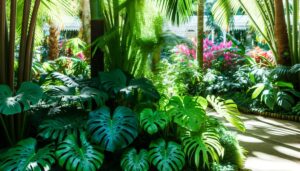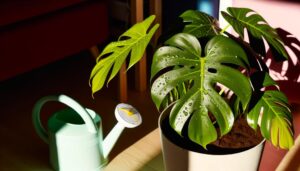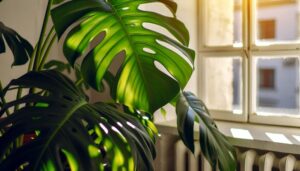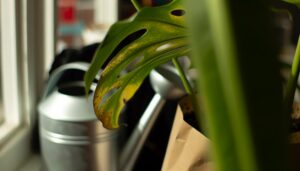Different Types of Monstera Plant: A Comprehensive Overview!
Monstera plants offer a variety of forms and features. Monstera Deliciosa boasts large, fenestrated leaves enhancing photosynthesis and reducing damage from elements.
Monstera Adansonii‘s elongated, heart-shaped leaves with numerous fenestrations thrive in indirect light. Monstera Obliqua has delicate, extreme fenestrations, requiring high humidity.
Monstera Siltepecana’s silver-patterned leaves prefer well-draining soil and indirect light. Monstera Standleyana features elongated, variegated leaves and a climbing habit.
Monstera Dubia shifts from small, heart-shaped juvenile leaves to larger, fenestrated mature ones. Understanding these unique traits can guide ideal care for each variety.
Explore further to deepen your knowledge of these fascinating plants.
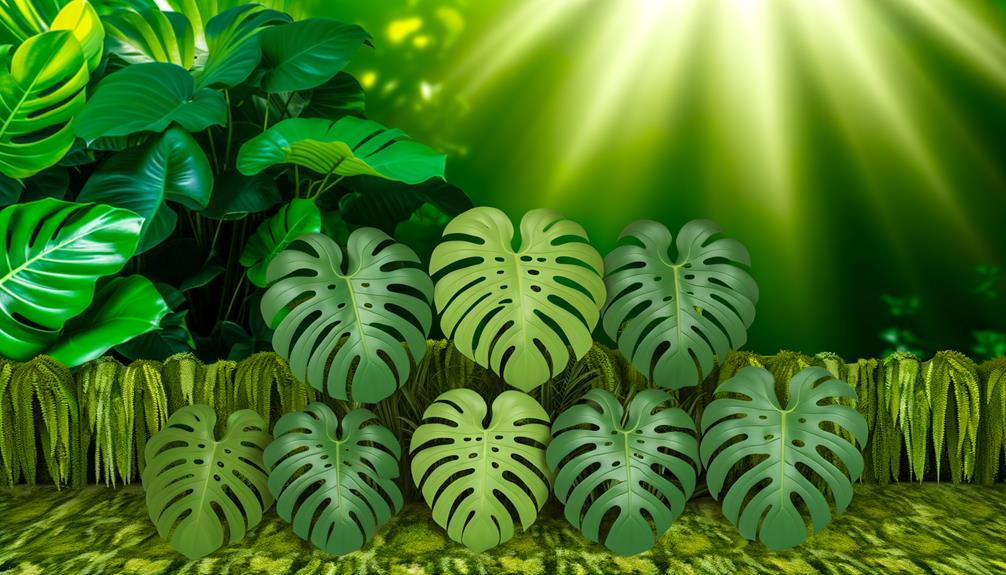
Key Takeaways
- Monstera Deliciosa has large, fenestrated leaves and aerial roots aiding in climbing.
- Monstera Adansonii features elongated, heart-shaped leaves with numerous small fenestrations.
- Monstera Obliqua is known for its delicate, extremely fenestrated foliage requiring high humidity.
- Monstera Siltepecana displays striking silver-patterned leaves and a robust growth habit.
- Monstera Standleyana has elongated, glossy leaves with white or yellow variegation and a climbing growth habit.
Monstera Deliciosa
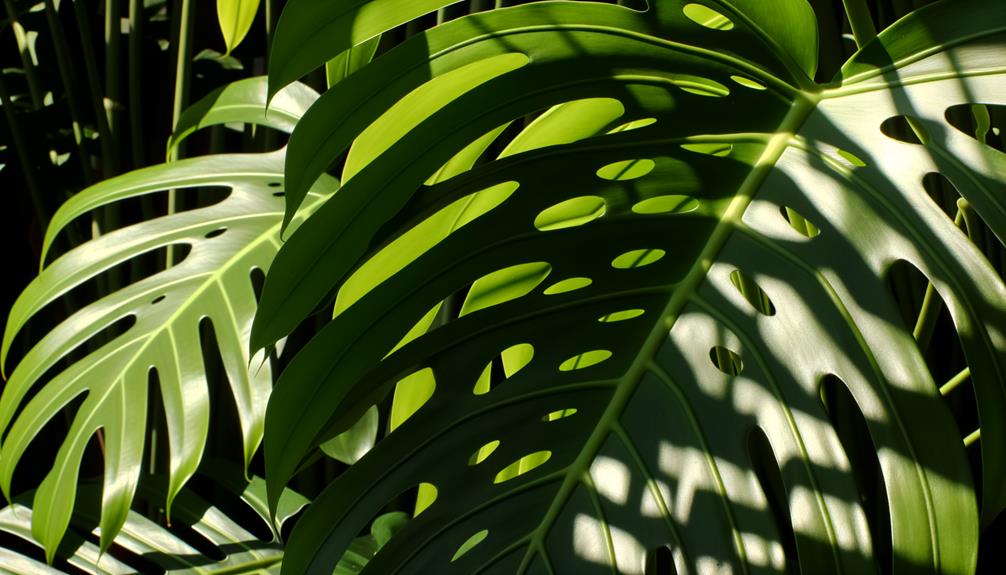
Monstera deliciosa, often referred to as the ‘Swiss Cheese Plant,’ is renowned for its large, fenestrated leaves that not only add a touch of the exotic to any space but also play a significant role in the plant’s adaptation to its natural habitat.
These perforations allow light to filter through to the lower leaves, enhancing photosynthesis efficiency. Additionally, the slits reduce wind resistance and minimize potential damage from heavy rain in tropical environments.
You’ll also notice that the aerial roots help the plant anchor itself to trees, optimizing its growth by climbing towards the canopy. Understanding these adaptations provides insight into why Monstera deliciosa thrives in both indoor and outdoor settings, making it a popular choice among plant enthusiasts.
Monstera Adansonii
While Monstera deliciosa impresses with its grand fenestrations, you’ll find Monstera adansonii equally fascinating due to its smaller, more numerous holes that give the leaves a lace-like appearance. This species, also known as the Swiss cheese plant, boasts a unique charm with its elongated, heart-shaped leaves. It’s a vining plant, making it perfect for hanging baskets or climbing supports.
Consider these attributes:
| Feature | Description |
|---|---|
| Leaf Shape | Elongated and heart-shaped |
| Fenestrations | Smaller, more numerous holes |
| Growth Habit | Vining, suitable for hanging baskets |
Monstera adansonii thrives in indirect light and prefers high humidity, echoing its tropical origins. Regular misting and well-draining soil help maintain its health. This plant’s moderate growth rate allows you to manage its spread easily, ensuring it remains an eye-catching centerpiece.
Monstera Obliqua
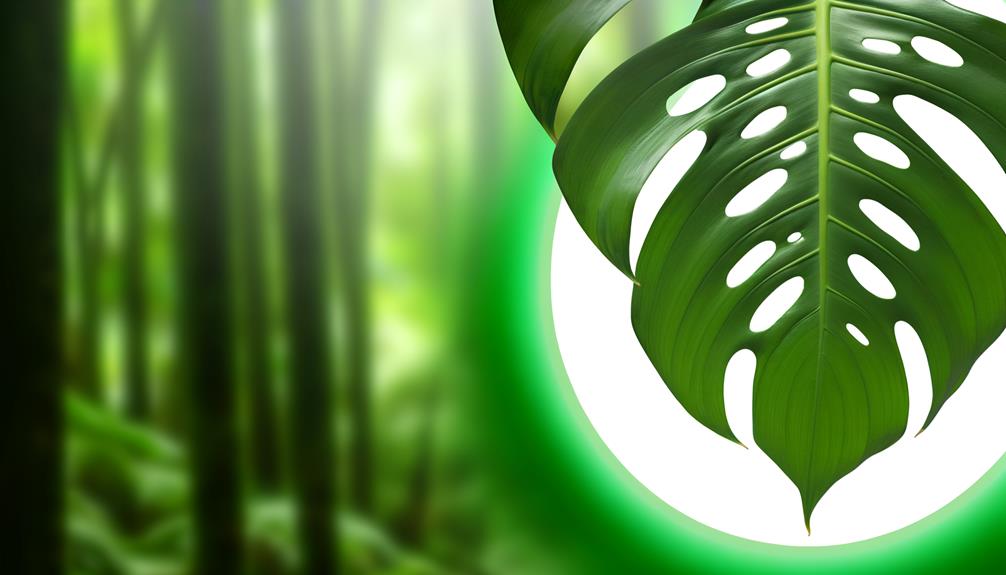
Famed for its delicate, almost ethereal foliage, Monstera obliqua captivates enthusiasts with its extreme fenestrations and paper-thin leaves. This rare species exhibits a fascinating leaf structure where the holes often outnumber the solid leaf material, creating a lace-like appearance.
You’ll notice that Monstera obliqua demands high humidity and consistent moisture to thrive, mimicking its natural rainforest habitat. Its fragile leaves require careful handling, making it less suitable for beginners. These plants grow slowly and are often confused with Monstera adansonii due to similar leaf perforations; however, obliqua’s holes are notably larger.
When cultivating Monstera obliqua, you’ll need to provide bright, indirect light and a well-draining soil mix to replicate its native environment.
Monstera Siltepecana
In your quest to explore diverse Monstera species, you’ll find Monstera siltepecana distinguished by its striking silver-patterned leaves and robust growth habit. This species captivates enthusiasts with its unique foliage and adaptability.
The leaves exhibit a fascinating gradient from silver to green, often adorned with dark green veins. Monstera siltepecana thrives in well-draining soil and indirect light, making it ideal for indoor cultivation.
- Leaves: Silver-patterned with dark veins
- Growth Habit: Vigorous climber
- Light Requirements: Indirect sunlight
- Soil: Well-draining mix
- Humidity: Prefers high humidity
You’ll appreciate its relatively low maintenance needs, which make it an excellent choice for both novice and experienced plant collectors. Understanding its needs supports healthy, vibrant growth, enhancing your botanical collection.
Monstera Standleyana
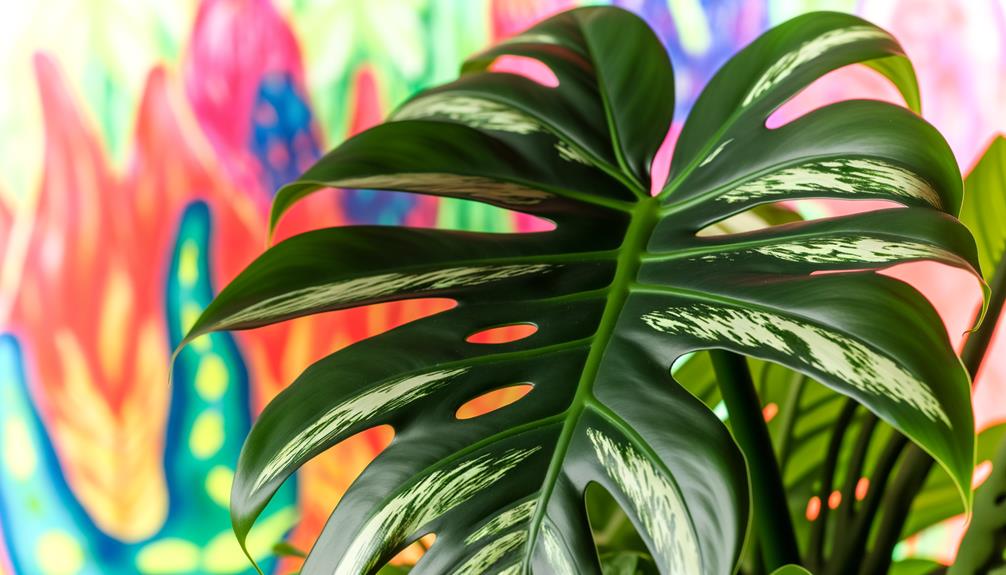
After admiring the striking Monstera siltepecana, you’ll find Monstera standleyana equally fascinating with its elongated, glossy leaves and distinctive white or yellow variegation.
This species, often referred to as the ‘Philodendron Cobra,’ thrives in bright, indirect light and requires well-draining soil to prevent root rot. The leaves, which can grow up to 20 centimeters long, exhibit a unique pattern that makes each specimen visually mesmerizing.
Analyze its growth habit: Monstera standleyana is a climbing plant, so providing a moss pole or similar support will encourage vertical growth and healthier foliage. Regular pruning helps maintain its shape and promotes new growth.
Ensure humidity levels remain high, mimicking its natural tropical environment, to optimize its overall health and variegation intensity.
Monstera Dubia
You’ll find Monstera dubia intriguing with its juvenile form exhibiting small, heart-shaped leaves that cling tightly to surfaces, creating a striking shingle-like pattern. As the plant matures, its leaves transform, becoming larger and fenestrated.
This species is an epiphyte, meaning it thrives by attaching to trees or other structures for support.
Key characteristics of Monstera dubia include:
- Juvenile leaf form: Small, heart-shaped, and shingle-like.
- Mature leaf form: Larger, fenestrated leaves.
- Growth habit: Epiphytic, climbing on surfaces.
- Natural habitat: Tropical rainforests of Central and South America.
- Care requirements: Prefers high humidity, indirect light, and well-draining soil.
Understanding these traits helps you appreciate the unique adaptation and care needs of Monstera dubia.
Conclusion
As you’ve explored, each type of Monstera offers unique characteristics and charm.
Fascinatingly, Monstera Deliciosa can grow leaves up to three feet long in the wild! This incredible growth showcases the plant’s adaptability and vigor.
Whether it’s the intricate fenestrations of the Monstera Adansonii or the delicate beauty of the Monstera Obliqua, these plants are marvels of nature.
So, immerse yourself in the world of Monsteras and let their diverse beauty captivate you.

